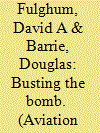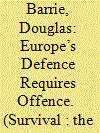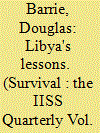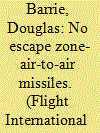| Srl | Item |
| 1 |
ID:
153367


|
|
|
|
|
| Summary/Abstract |
Sometime late last year, ground-launched cruise-missile batteries left Russia’s Kapustin Yar test range, possibly on flatbed rail trucks.1 Amongst these, United States officials contend, was a system that drives a coach and horses through the 1987 Intermediate-Range Nuclear Forces (INF) Treaty. Washington asserts that the cruise missile deployed at the end of 2016 has a range significantly above the INF Treaty threshold. Russia has so far dismissed the US claims.
|
|
|
|
|
|
|
|
|
|
|
|
|
|
|
|
| 2 |
ID:
073604


|
|
|
| 3 |
ID:
012557


|
|
|
|
|
| Publication |
Oct 8-14 1997.
|
| Description |
34-37
|
|
|
|
|
|
|
|
|
|
|
|
|
|
|
|
| 4 |
ID:
177909


|
|
|
|
|
| Summary/Abstract |
To preclude a severely damaged or more likely dissolved NATO, NATO Europe would need the capabilities to fight offensively and to win.
|
|
|
|
|
|
|
|
|
|
|
|
|
|
|
|
| 5 |
ID:
116645


|
|
|
|
|
| Publication |
2012.
|
| Summary/Abstract |
After the Libyan regime of Colonel Muammar Gadhafi stepped up its military campaign against rebel forces in February and March 2011, in defiance of UN Security Council Resolution (UNSCR) 1970, pressure to impose a no-fly zone - which would require attacking the regime's air defences - began to mount. On 17 March, the Security Council, with China, Russia, Germany, Brazil and India abstaining, passed Resolution 1973 authorising nations to 'take all necessary measures … to protect civilians and civilian populated areas under threat of attack in the Libyan Arab Jamahiriya, including Benghazi, while excluding a foreign occupation force of any form on any part of Libyan territory'. It also imposed a no-fly zone across Libya, and authorised member states to take all necessary measures to enforce it. The resolution did not provide an explicit mandate to provide direct military aid to the rebels, which would probably have provoked a veto from Russia or China.
|
|
|
|
|
|
|
|
|
|
|
|
|
|
|
|
| 6 |
ID:
016830


|
|
|
|
|
| Publication |
March 16-22, 1994.
|
| Description |
29-36
|
|
|
|
|
|
|
|
|
|
|
|
|
|
|
|